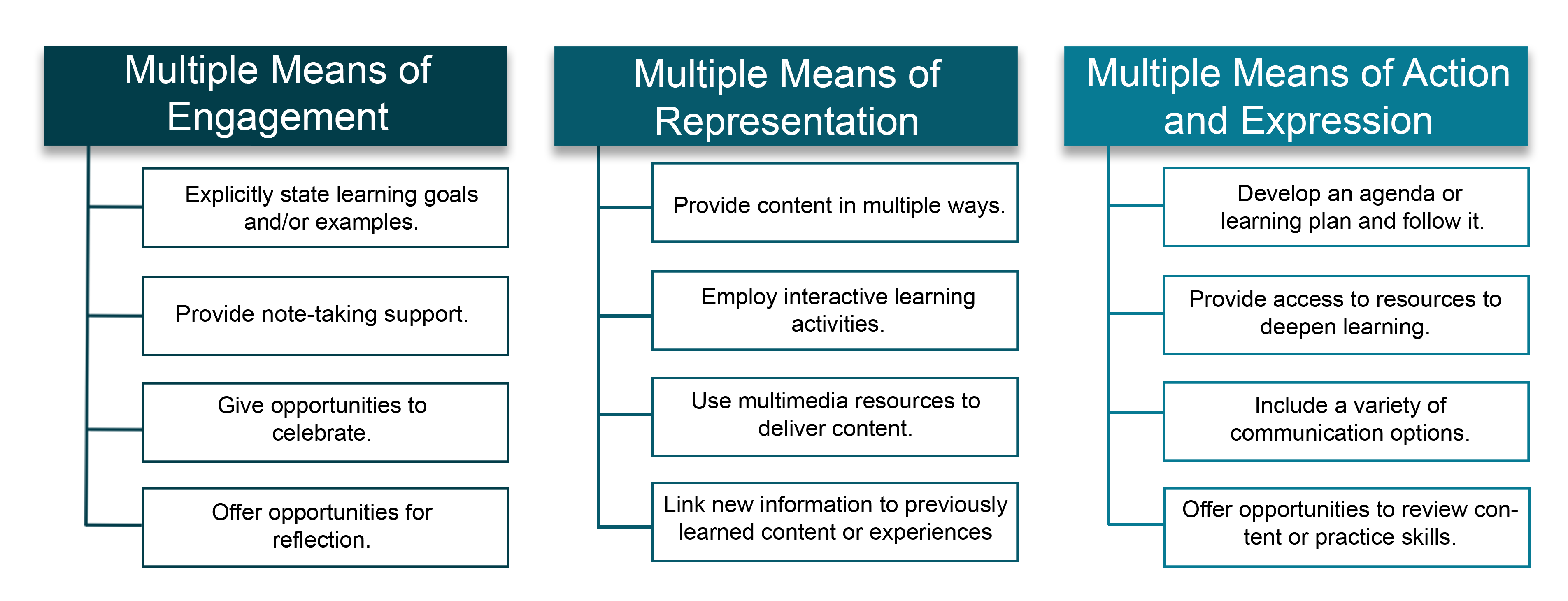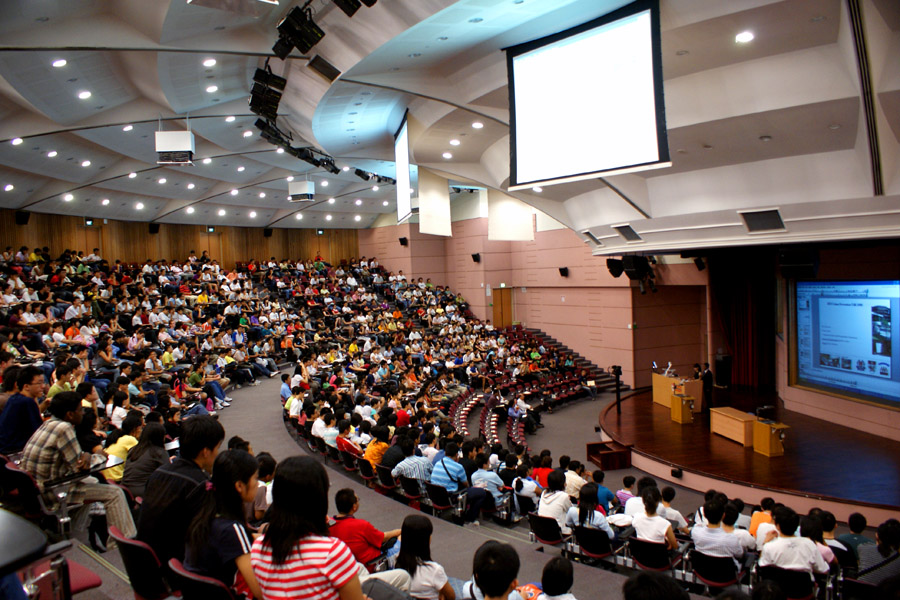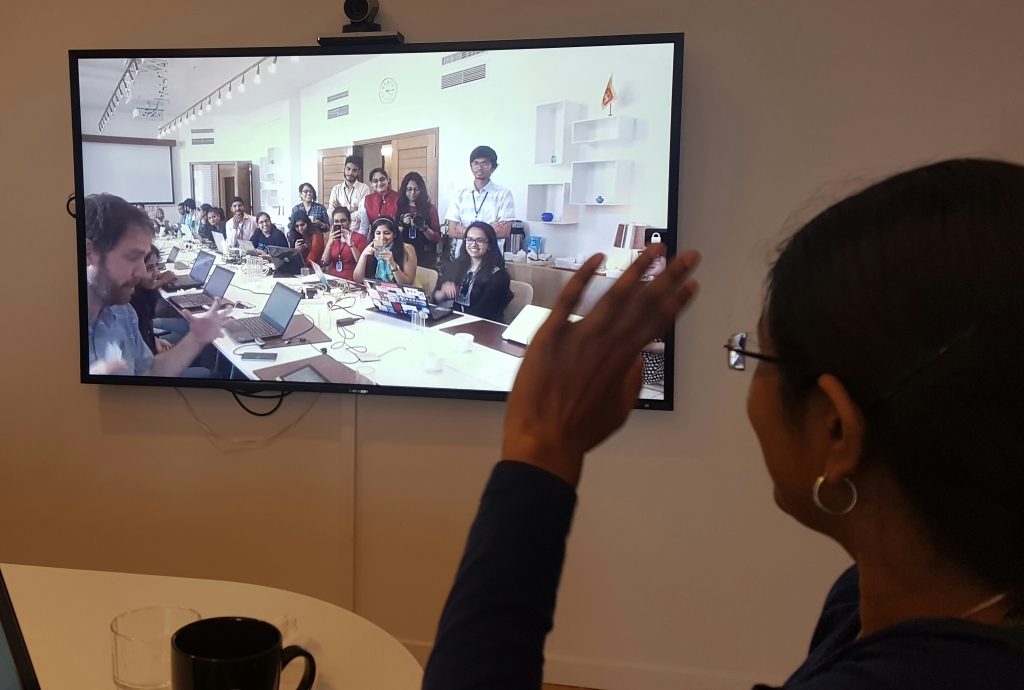1.3: Examples of UDL
We have offered a couple of examples of Universal Design (UD) in the previous topic of this module, but what does UDL look like? The following are some general examples organized by the UDL Guideline principles. (Mohawk College, 2021).
You may find it helpful to see what UDL can look like based on your teaching and learning space. Here are some examples of UDL in a variety of learning environments. To view a higher resolution version of the graphic below, right-click on the graphic and choose “open image in a new tab.”


Traditional Learning Spaces

There are many names for what we are calling “traditional” learning spaces; you may refer to these learning environments as face-to-face, in-person, or in-class. Whatever label works for you, the examples below outline what UDL can look like when your learners are physically present in a defined classroom space and content is being delivered synchronously:
- Provide opportunities for learners to move in the classroom space to form groups or pairs to complete learning activities
- Make time throughout the class/session to stop and have learners reflect
- Give options for how learners can ask questions, which may include raising hands, using a backchannel or submitting written questions
- Offer assessments that provide time and space for prompt feedback (from the educator or peers) within the lesson
Online Learning Environments

For the purposes of this module, “online” learning environments are defined as content delivered and assessed (as required), fully technology-enabled and without any traditional learning space elements. The examples below outline what UDL can look like in these online learning environments where content may be being delivered synchronously and/or asynchronously:
- Provide opportunities to review content asynchronously
- Offer options for learning participation, which may include using chat functions, discussing topics through the learning management system, and asking questions on screen
- Develop interactive learning activities such as polls, check-in questions, discussion topics for breakout rooms
- Proactively include additional time and/or attempts on assessments for all learners
Blended or Technology-Mediated Learning

Blended or technology-mediated learning spaces are, for the purposes of this module, defined as a combination of traditional and online learning environments where content may be delivered synchronously and/or asynchronously. The examples below outline how UDL can be implemented in these teaching and learning environments:
- Offer multimedia resources online that solidify concepts taught in the traditional class environment
- Include clear navigation instructions so learners can manage both learning spaces
- Suggest communication options for in-person and online
- Provide assessment opportunities that take place in the “traditional” learning space, as well as online to ensure a variety of not only assessment methods, but also environments
You will notice that many of these examples can be adapted to any teaching and learning environment. You will also notice that UDL does not need to be large-scale projects or require you to dismantle a course. UDL can be small changes over time, offering more options when and where you can, reflecting on the impact of those changes, and continuously improving your teaching and your students’ learning. The end result will be a more inclusive, equitable and accessible learning space for all of your learners.
Activity 3: Minimizing Barriers to Hyflex Learning
“Hybrid flexible” or hyflex is defined as a course design and delivery approach that “combines face-to-face (F2F) and online learning”, with “Each class session and learning activity…offered in-person, synchronously online, and asynchronously online” HyFlex allows the learner to determine how to participate given students flexibility and the capacity to engage with the course content regardless of location or time (EDUCAUSE, 2020).
Imagine you are teaching a hyflex course, how will you apply UDL principles to minimize the following barriers?
- Engagement: Online students are missing the social component of in-person learning
- Representation: Only using a PowerPoint to present new information
- Action & Expression: Only multiple choice and written response to assess students’ learning
You are invited to reflect in the way that works best for you, which may include writing, drawing, creating an audio or video file, mind map or any other method that will allow you to reflect and refer back to your thoughts.
Alternatively, a text-based note-taking space is provided below. Any notes you take here remain entirely confidential and visible only to you. Use this space as you wish to keep track of your thoughts, learning, and activity responses. Download a text copy of your notes before moving on to the next page of the module to ensure you don’t lose any of your work!
References
EDUCAUSE. (2020). 7 things you should know about the hyflex course model. https://library.educause.edu/resources/2020/7/7-things-you-should-know-about-the-hyflex-course-model
Benton Kearney, D. (2021). UDL Examples [Graphic]. UDL: Getting Started Presentation, Mohawk College.
Mörtsell, S. (2017). Netha and Video call Sweden India edit-a-thon [Photograph]. Wikimedia Commons. https://commons.wikimedia.org/w/index.php?curid=56800623. CC BY-SA 4.0.
teddy-rised (Photographer). (2008). That Huge Lecture Theatre! [Photograph]. Flickr. https://flic.kr/p/5hJ8dN. CC BY-NC-ND 2.0.

